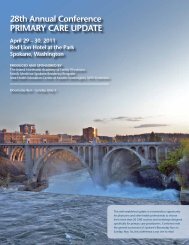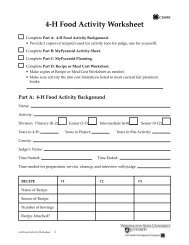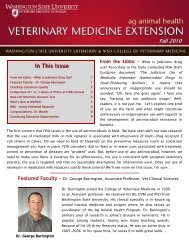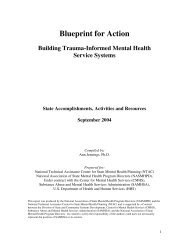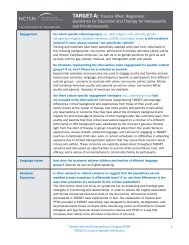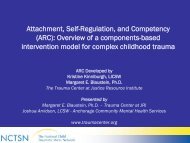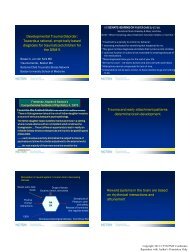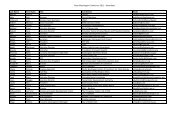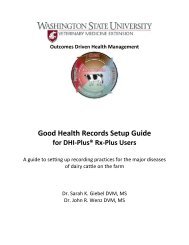Calving Time Management for Beef Cows and ... - OSU Fact Sheets
Calving Time Management for Beef Cows and ... - OSU Fact Sheets
Calving Time Management for Beef Cows and ... - OSU Fact Sheets
- No tags were found...
You also want an ePaper? Increase the reach of your titles
YUMPU automatically turns print PDFs into web optimized ePapers that Google loves.
E-1006<strong>Calving</strong> <strong>Time</strong> <strong>Management</strong><strong>for</strong> <strong>Beef</strong> <strong>Cows</strong><strong>and</strong> HeifersAnimal Science DepartmentOklahoma Cooperative Extension ServiceOklahoma State University
<strong>Calving</strong> <strong>Time</strong> <strong>Management</strong> <strong>for</strong> <strong>Beef</strong> <strong>Cows</strong> <strong>and</strong> HeifersMay 2008Recognize Normal <strong>Calving</strong>_________________________________________________________________ 1The Three Stages of Parturition_____________________________________________________________ 1Stage 1___________________________________________________________________________________________________ 1Stage 2___________________________________________________________________________________________________ 1Stage 3___________________________________________________________________________________________________ 1Dystocia_______________________________________________________________________________ 2Causes of Dystocia_________________________________________________________________________________________2Effects of Dystocia on the Calf________________________________________________________________________________2Effects of Dystocia on post-calving Fertility______________________________________________________________________2Prepare Be<strong>for</strong>e Helping__________________________________________________________________ 3Signs of Impending <strong>Calving</strong> in <strong>Cows</strong> or Heifers________________________________________________ 3When <strong>and</strong> How to Examine the Cow________________________________________________________ 3Proper Placement of Obstetrical Chains_____________________________________________________ 4Forced Extraction of the Calf______________________________________________________________ 5Anterior Presentation____________________________________________________________________ 5Posterior Presentation___________________________________________________________________ 5Other Ideas on Pulling Calves______________________________________________________________ 6Abnormal Presentations__________________________________________________________________ 6Two Front Legs Presented: Head Retained_____________________________________________________________________ 6Head Between Forelegs_____________________________________________________________________________________7Head Out: one or Both Forelegs Retained_______________________________________________________________________7Breech Presentation________________________________________________________________________________________7Twins____________________________________________________________________________________________________7Rotating the Calf at Parturition to Aid in Delivery_____________________________________________ 8Prolapses______________________________________________________________________________ 9Summary______________________________________________________________________________ 9References_____________________________________________________________________________ 9Gestation Table_________________________________________________________________________ 10Glenn SelkProfessor, Extension Animal Reproduction SpecialistAnimal ScienceDave Sparks, DVMArea Food/Animal Quality <strong>and</strong> Health SpecialistOklahoma Cooperative Extension Service
Oklahoma State University, in compliance with Title VI <strong>and</strong> VII of the Civil Rights Act of 1964, Executive Order 11246 as amended, Title IX of the Education Amendments of 1972, Americans withDisabilities Act of 1990, <strong>and</strong> other federal laws <strong>and</strong> regulations, does not discriminate on the basis of race, color, national origin, gender, age, religion, disability, or status as a veteran in any of its policies,practices, or procedures. This includes but is not limited to admissions, employment, financial aid, <strong>and</strong> educational services.Issued in furtherance of Cooperative Extension work, acts of May 8 <strong>and</strong> June 30, 1914, in cooperation with the U.S. Department of Agriculture, Robert E. Whitson, Director of Cooperative ExtensionService, Oklahoma State University, Stillwater, Oklahoma. This publication is printed <strong>and</strong> issued by Oklahoma State University as authorized by the Vice President, Dean, <strong>and</strong> Director of the Division ofAgricultural Sciences <strong>and</strong> Natural Resources <strong>and</strong> has been prepared <strong>and</strong> distributed at a cost of $2.45 per copy. 0508 JA
Calf losses at calving time are often a result ofdystocia (difficult calving) problems. Many of theselosses occur to calves born to first calf heifers <strong>and</strong> canbe prevented if the heifers <strong>and</strong> cows are watched closely<strong>and</strong> the dystocia problems detected <strong>and</strong> corrected early.A veterinarian should h<strong>and</strong>le serious <strong>and</strong> complicatedcalving problems. Ranchers must use good judgmentin their decisions as to which problems will requireprofessional help, <strong>and</strong> the earlier help is sought thegreater the survival rate of both cow <strong>and</strong> calf.Recognize Normal <strong>Calving</strong>If the calf is normally presented (Figure 1) <strong>and</strong> thepelvic area is large enough, the vast majority of animalswill give birth without assistance. Recognizing a normalcalving is just as important as knowing when a calvingis abnormal. This way you will not give help when it isnot needed.The Three Stages of ParturitionStage 1The first stage of parturition is dilation of the cervix.The normal cervix is tightly closed right up until thecervical plug is completely dissolved. In stage 1, cervicaldilation begins some four to 24 hours be<strong>for</strong>e the actualbirth. During this time the progesterone block is nolonger present <strong>and</strong> the uterine muscles are becomingmore sensitive to all factors that increase the rate <strong>and</strong>strength of contractions. At the beginning, the contractile<strong>for</strong>ces primarily influence the relaxation of the cervix bututerine muscular activity is still rather quiet. Stage 1 islikely to go completely unnoticed, but there may be somebehavioral differences such as isolation or discom<strong>for</strong>t.Near the end of stage 1 ranchers may observe elevationof the tail, switching of the tail, <strong>and</strong> increased mucousdischarge.Stage 2The second stage of parturition is defined as thedelivery of the newborn. It begins with the entrance ofthe membranes <strong>and</strong> fetus into the pelvic canal <strong>and</strong> endswith the completed birth of the calf. The second stageis the one producers are really interested in becausethis is where all the action is. Clinically the onset ofstage 2 is marked by the appearance of membranes orwater bag at the vulva. The traditional texts, fact sheets,magazines, <strong>and</strong> other publications state that stage 2 incattle lasts from two to four hours. Data from OklahomaState University <strong>and</strong> the USDA experiment station atMiles City, Montana, would indicate that stage 2 ismuch shorter being approximately one hour <strong>for</strong> heifers<strong>and</strong> one-half hour <strong>for</strong> adult cows. See When <strong>and</strong> Howto Examine a Cow on page 3. In heifers, not only is thepelvic opening smaller, but also the soft tissue has neverbeen exp<strong>and</strong>ed. Older cows have had deliveries be<strong>for</strong>e<strong>and</strong> birth should go quite rapidly unless there is someabnormality such as a very large calf, backwards calf, legback, or twins.Stage 3The third stage of parturition is the shedding ofthe placenta or fetal membranes. In cattle this normallyoccurs in less than eight to 12 hours. The membranesare considered retained if after 12 hours they have notbeen shed. Years ago it was considered necessary toremove the membranes by manually unbuttoning theattachments. Research has shown that manual removalis detrimental to uterine health <strong>and</strong> future conceptionrates. Administration of antibiotics usually will guardagainst infection <strong>and</strong> the placenta will slough in fourto seven days. Contact your veterinarian <strong>for</strong> the propermanagement of retained placenta.DystociaWhat is dystocia or a difficult birth? Traditionally, itis any birth that has needed assistance. According to thatdefinition, any unassisted birth was a normal birth, butby the definition an unassisted birth could still result inweak or dead calf at birth. A more modern definition ofdystocia would be a birth that needs assistance or resultsin a weakened or dead calf or injury to the dam.Figure 1. An anterior presentation.Causes of DystociaWhat are the causes of dystocia? Most commonis relative fetal oversize, which could be defined asa calf too big, pelvis too small, or both. As <strong>for</strong> calvingdifficulty, prevention is worth a pound of cure. Proper<strong>Calving</strong> <strong>Time</strong> <strong>Management</strong> <strong>for</strong> <strong>Beef</strong> <strong>Cows</strong> <strong>and</strong> Heifers 1
sire selection is a key to preventing calving difficulty.Underdeveloped heifers <strong>and</strong> heifers bred to bulls withlarge birth weights are both factors that cause increasedincidence of difficult births. The second most prevalentcause is abnormal presentation or position. The normalpresentation in cattle is anterior presentation or headfirst <strong>and</strong> the normal position would be right side up withhead <strong>and</strong> <strong>for</strong>e limbs extended into the pelvic canal. Anyposition that involves the calf’s head turned back or oneof the legs turned back is abnormal. Remember a normaldelivery cannot be achieved unless the head <strong>and</strong> bothfront limbs are presented into the pelvic canal <strong>and</strong> onthrough the vulva. A third cause of dystocia would belack of uterine contractions or uterine fatigue. The causesof this are complex <strong>and</strong> not completely understood.Sometimes hormonal imbalances may result in the cervixnot being completely dilated or uterine contractions notoccurring frequently or strongly enough. Low calciumlevels such as seen with milk fever or grass tetany may beresponsible. In any case those problems usually requirethe assistance of a veterinarian to correct. Other causes ofdystocia are twins or genetic mistakes (fetal monsters).Effects of Dystocia on the CalfWhat are the effects of dystocia or difficult birthon the calf? Obvious to everyone is a dead calf at birthor one killed during the assistance process. Additionaleffects include trauma such as leg fractures, ruptureddiaphragm, <strong>and</strong> nerve damage due to excessive pulling,improper placement of chains, or the development of ahiplock. A third <strong>and</strong> greatly overlooked effect is a weakcalf, sometimes called weak calf syndrome, which maybe brought on by a prolonged stage 2. This is due toincreased time exposed to increased pressure associatedwith increased uterine contractions <strong>and</strong> straining of thedam.A prolonged stage 2 with no progress in deliveryof the calf is going to result in decreased oxygen <strong>and</strong>increased carbon dioxide to the fetus. Such calves donot have normal respiratory ef<strong>for</strong>ts. They do not havestrong gasping <strong>and</strong> panting ef<strong>for</strong>ts. They do not haverapid respiration or heart rates necessary to distributeoxygen to the tissues <strong>and</strong> carbon dioxide back to thelungs. Lactic acid <strong>and</strong> carbon dioxide levels remain quitehigh. These calves are depressed, they do not sit up well,they do not shake their heads <strong>and</strong> ears, <strong>and</strong> if weather iscold they do not shiver to warm themselves. Shiveringincreases metabolism, which increases heat. These calveshave poor metabolism to begin with <strong>and</strong> their bodytemperature consequently drops. Even those that firstappeared to breath <strong>and</strong> sit up normally soon becomedepressed, are slow to rise, <strong>and</strong> are slow to nurse. Manydo not nurse without assistance <strong>and</strong> die within 12 to24 hours. Even those that do nurse, may nurse too late<strong>for</strong> good antibody absorption. In summary, the effect ofdystocia is not just dead calves <strong>and</strong> injured heifers, butalso weak <strong>and</strong> sick calves.%Effects of Dystocia on Post-calving FertilityIn addition to being the greatest cause of babycalf mortality, calving difficulty markedly reducesreproductive per<strong>for</strong>mance during the next breedingseason.Results from a Montana study (Doornbos, et al., 1984)showed that heifers receiving assistance in early stage 2of parturition returned to heat earlier in the post-calvingperiod <strong>and</strong> had higher pregnancy rates than heifersreceiving traditionally accepted obstetric assistance(Figure 2). In this study heifers were either assistedwhen the fetal membranes (water bag) appeared (Early)or were allowed to progress normally <strong>and</strong> assisted onlyif calving was not completed within two hours of theappearance of the water bag (Late).Heifers that were allowed to endure a prolongedlabor had a 20% lower rate of cycling at the start ofthe next breeding season. In addition, the rebreedingpercentage was 17% lower than the counterparts thatwere given assistance in the first hour of labor.Prolonged deliveries of baby calves (in excess of oneto one <strong>and</strong> a half hours) often result in weakened calves<strong>and</strong> reduced rebreeding per<strong>for</strong>mance in young cows.1009080706050403020100Reproduction Success of Heifers GivenEarly or Late Assistance87Early88Figure 2. Impact of early or late assistance in subsequentrebreeding per<strong>for</strong>mance of first calf heifers. Doornbos, et al.1984.Prepare Be<strong>for</strong>e Helping% Cycling at start of breeding% Pregnant after breeding<strong>Time</strong> of assistanceLate• Equipment: Be<strong>for</strong>e calving season starts do awalk through of pens, chutes, <strong>and</strong> calving stalls.Make sure that all are clean, dry, strong, safe, <strong>and</strong>functioning correctly. This is a lot easier to do on asunny afternoon than on a cold dark night when youneed them.• Protocol: Be<strong>for</strong>e calving season starts develop a planof what to do, when to do it, who to call <strong>for</strong> help (alongwith phone numbers), <strong>and</strong> how to know when youneed help. Make sure all family members or helpersare familiar with the plan. It may help to write it out70682 <strong>Calving</strong> <strong>Time</strong> <strong>Management</strong> <strong>for</strong> <strong>Beef</strong> <strong>Cows</strong> <strong>and</strong> Heifers
<strong>and</strong> post copies in convenient places. Talk to the localveterinarian about the protocol <strong>and</strong> incorporate his/her suggestions. Your veterinarian will be a lot morehelpful when you have an emergency during thekids’ school program if you have talked a few timesduring regular hours.• Lubrication: Many lubricants have been used <strong>and</strong>one of the best lubricants is probably the simplest –non-detergent soap <strong>and</strong> warm water.• Supplies: The stockman should always have in hismedicine chest the following: disposable obstetricalsleeves, non-irritant antiseptic, lubricant, obstetricalchains (60 inch <strong>and</strong>/or two 30 inch chains), twoobstetrical h<strong>and</strong>les, mechanical calf pullers, <strong>and</strong>injectable antibiotics. Do not <strong>for</strong>get the simple thingslike a good flashlight with extra batteries <strong>and</strong> someold towels or a roll of paper towels. It may be helpful<strong>for</strong> you to have all these things <strong>and</strong> other items youmay want to include packed into a 5 gallon bucket tomake up an obstetrical kit so you can grab everythingat once.Signs of Impending <strong>Calving</strong>in <strong>Cows</strong> or HeifersAs the calving season approaches, the cows willshow typical signs that will indicate parturition isimminent. Changes that are gradually seen are udderdevelopment or making bag <strong>and</strong> the relaxation <strong>and</strong>swelling of the vulva or springing. These indicate thecow is due to calve in the near future. There is muchdifference between individuals in the development ofthese signs <strong>and</strong> certainly age is a factor. The first calfheifer, particularly in the milking breeds, develops udder<strong>for</strong> a very long time, sometimes <strong>for</strong> two or three monthsbe<strong>for</strong>e parturition. The springing can be highly variabletoo. Most people notice that Brahman influence cattleseem to spring much more than does a Holstein.Typically, in the immediate two weeks precedingcalving, springing becomes more evident, the udder isfilling, <strong>and</strong> one of the things that might be seen is theloss of the cervical plug. This is a very thick tenacious,mucous material hanging from the vulva. It may beseen pooling behind the cow when she is lying down.Some people mistakenly think this happens immediatelybe<strong>for</strong>e calving, but in fact this can be seen weeks be<strong>for</strong>eparturition <strong>and</strong> there<strong>for</strong>e is only another sign that thecalving season is here.The immediate signs that usually occur within24 hours of calving would be relaxation of the pelvicligaments <strong>and</strong> strutting of the teats. These can be fairlydependable <strong>for</strong> the owner that watches his cows severaltimes a day during the calving season. The casual observeror even the veterinarian who is knowledgeable of thesigns but sees the herd infrequently cannot accuratelypredict calving time from these signs. The relaxationof the pelvic ligaments really cannot be observed infat cows (body condition score 7 or greater). However,relaxations of the ligaments can be seen very clearly inthin or moderate body condition cows <strong>and</strong> can be a signof impending parturition within the next 12 to 24 hours.These changes are signs the producer or herdsman canuse to more closely pinpoint calving time. Strutting ofthe teats is not really very dependable. Some heavymilking cows will have strutting of the teats as much astwo or three days be<strong>for</strong>e calving <strong>and</strong> on the other h<strong>and</strong>,a thin poor milking cow may calve without strutting ofthe teats.Another thing that might be seen in the immediate 12hours be<strong>for</strong>e calving would be variable behavior such asa cow that does not come up to eat or a cow that isolatesherself into a particular corner of the pasture. However,most of them have few behavioral changes until theparturition process starts.When <strong>and</strong> How to Examine the CowIt is important to know with complete confidenceexactly when <strong>and</strong> how long to leave the cow <strong>and</strong> whento seek help. An issue facing the rancher at calvingtime is the amount of time heifers or cows are allowedto be in labor be<strong>for</strong>e assistance is given. Traditionaltextbooks, fact sheets, <strong>and</strong> magazine articles state thatstage 2 of labor lasted from two to four hours. Stage 2 isdefined as that portion of the birthing process from thefirst appearance of the water bag until the baby calf isdelivered. Data from Oklahoma State University <strong>and</strong> theUSDA experiment station at Miles City, Montana, clearlyshow that stage 2 is much shorter, lasting approximately60 minutes in first calf heifers <strong>and</strong> 30 minutes in maturecows (Table 1).In these studies, heifers that were in stage 2 labormuch more than one hour or cows that were in stage2 much more than 30 minutes definitely neededassistance. Research in<strong>for</strong>mation also shows that calvesfrom prolonged deliveries are weaker <strong>and</strong> more diseaseprone, even if born alive. In addition, cows or heiferswith prolonged deliveries return to heat later <strong>and</strong> are lesslikely to be bred <strong>for</strong> the next calf crop. Consequently agood rule of thumb: If the heifer is not making significantprogress one hour after the water bag or feet appear,examine the heifer to see if you can provide assistance.Mature cows should be watched <strong>for</strong> only 30 minutesbe<strong>for</strong>e a vaginal examine is conducted. If you cannotsafely deliver the calf yourself at this time, call your localveterinarian immediately.Table 41.1 – Research results <strong>for</strong> length of stage 2 parturition.Study No. of Animals Length of Stage 2USDA(Montana)* 31 mature cows 22.5 min.USDA(Montana)* 29 first calf heifers 54.1 min.Oklahoma StateUniversity** 35 first calf heifers 55.0 min.*Doornbos, et al. 1984. JAS: 59:1**Putnam, et al. 1985. Therio: 24:385<strong>Calving</strong> <strong>Time</strong> <strong>Management</strong> <strong>for</strong> <strong>Beef</strong> <strong>Cows</strong> <strong>and</strong> Heifers 3
Most ranches develop heifers fully <strong>and</strong> use calvingease bulls to prevent calving difficulties. However, a fewdifficult births are going to occur each calving season.Using the concept of evening feeding to get more heiferscalving in daylight <strong>and</strong> giving assistance early willsave a few more calves. This results in healthier moreproductive two-year cows to rebreed next year.If nothing is showing after a period of intensivestraining of second-stage labor – a period ofapproximately 30 minutes in a cow <strong>and</strong> 60 minutes in aheifer – then examine her to determine if presentation isnormal. Wash the vulva, anus, <strong>and</strong> the area in betweenusing soap <strong>and</strong> warm water. Using a disposable sleeve(shoulder length) <strong>and</strong> a good lubricant (usually availablefrom your veterinarian), insert your h<strong>and</strong> slowly <strong>and</strong> donot rupture the waterbag. If the calf’s presentation is notan anterior (Figure 1) or posterior position (Figure 3) orif the calf is very large or the heifer small, you may wantto seek professional help.Proper Placement of Obstetrical ChainsTo properly use obstetrical chains when assistingwith a difficult birth, follow the example in Figure 4. Toattach the chain, loop it around the thin part of the legabove the fetlock. Then, make a half hitch <strong>and</strong> tighten itbelow the joint <strong>and</strong> above the foot. Make certain that thechain is positioned in such a manner that it goes over thetop of the toes. In this way the pressure is applied so as topull the sharp points of the calf’s hooves away from thesoft tissue of the vaginal wall.Figure 1. An anterior presentation.Forced Extraction of the CalfIt is very important at all times to exert pressure onlywhen the animal strains <strong>and</strong> to relax completely whenthe patient relaxes. The old idea of maintaining a steadypressure during assistance is wrong, unless the cow hasalready given up <strong>and</strong> no assistance is coming from her.Excessive or improper pressure often causes injuriesto the dam such as vaginal tears, uterine rupture, paralysis,or uterine prolapse. All can usually be prevented butwhen they occur they need the immediate attention ofyour veterinarian.Vaginal tears generally heal with proper antibiotictherapy. Uterine rupture usually results in death. Someanimals will recover from calving paralysis but mayrequire prolonged care <strong>and</strong> may not breed again.Pulling on a calf should only be done when thepresentation <strong>and</strong> posture of the calf are normal. Thisapplies both to an anterior position (Figure 1) <strong>and</strong> aposterior position (Figure 3). Excess <strong>for</strong>ce should neverbe used in pulling a calf. In most cases, no more than twomen should be allowed to pull <strong>and</strong> then only when thecow strains. Lubricant <strong>and</strong> patience will often solve thetightest case. Use extreme caution if a mechanical pulleris being used.Figure 3. A posterior presentation.4 <strong>Calving</strong> <strong>Time</strong> <strong>Management</strong> <strong>for</strong> <strong>Beef</strong> <strong>Cows</strong> <strong>and</strong> Heifers
Place loop above <strong>and</strong> halfhitch below fetlock joint. Connectingchain should be on the top of the leg.Figure 41.4 – Proper placement of obstetrical chains.The first step is to examine the cow to check calfposition <strong>and</strong> determine if assistance is necessary. It isgenerally easier to correct any abnormal presentation ifthe cow is st<strong>and</strong>ing. If a cow or heifer will not get up,she should be so placed that she is not lying directly onthe part of the calf which has to be adjusted. Thus, if thecalf’s head is turned back toward the cow’s right flank,the cow should be made to lie on her left flank so that thecalf’s head is uppermost. This provides more room in theuterus <strong>for</strong> manipulation.Once the calf is in a correct anterior or posteriorposition, delivery will be easier if the cow is lying down.When the calf’s limbs are located, find out whether theyare <strong>for</strong>elimbs or hindlimbs. To do this start by feeling thefetlock <strong>and</strong> moving the h<strong>and</strong> up the limb. In the hindlimbthe next joint is the hock with the prominent point. In the<strong>for</strong>elimb there is also a prominent point, the point of theelbow, but be<strong>for</strong>e this is reached one can feel the kneejoint, which is flat <strong>and</strong> has no prominences.The calf may be alive or dead. Sometimes movementscan be detected in a live calf by placing the fingers in themouth, seizing the tongue, or touching the eyelids.If the genital passage of the cow is dry or if the calfitself is dry, plenty of lubricant should be used. Attemptsto repel (push back) the calf should be made betweenlabor pains. Similarly, attempts to deliver the calf bytraction will be a lot easier if they are made to coincidewith the contractions of the cow.Anterior PresentationAn anterior presentation is <strong>for</strong>efeet first, headresting on the limbs, <strong>and</strong> the eyes level with the knees(Figure 1). As stated above, in this presentation the cowdoes not usually require assistance, unless it is a heiferat first calving, the calf is dead, or the calf is too big <strong>for</strong>the cow.If the calf is dead, tie a chain around the head behindthe ears <strong>and</strong> pass it through the mouth. This will preventthe head from twisting when the limbs are being pulled.With a live calf you can do this by placing a h<strong>and</strong> on thehead <strong>and</strong> ensuring that the head is kept straight. Tractionshould not be exerted simultaneously on the head <strong>and</strong>limbs until the head enters the pelvis. A large calf, withshoulders too wide <strong>for</strong> the pelvis, is sometimes held upat this stage. If so, pull one limb only so that the elbow<strong>and</strong> shoulder of one limb only enter the pelvis. Then,while the pull on the limb is continued, the other limbis treated in the same way until both feet project equallyfrom the genital passage. Now apply traction on bothlimbs <strong>and</strong> on the head until the head protrudes fromthe vulva, <strong>and</strong> from this stage the principle traction isexerted on the limbs again.It can be seen that traction on both limbs at the sametime will result in both shoulders entering the pelvis atonce. If the shoulders of a wide-chested calf can be madeto enter on a slant <strong>and</strong> can be pulled through in thatposition, delivery will be made easier.IMPORTANT: Traction on the calf in the earlystages should be exerted upward (in the direction ofthe tailhead) <strong>and</strong> not downward. Once the calf is in thepelvic cavity, traction should be straight backward <strong>and</strong>then downward. The calf thus passes through the birthcanal in the <strong>for</strong>m of an arc.If the passage of the hind end of the calf presentsany difficulty, the body of the calf should be grasped <strong>and</strong>twisted to an angle of about 45 degrees. Delivery is thenmade with the calf half-turned on its side. This allows <strong>for</strong>easier passage of a calf with well-developed stifle joints.Sometimes a calf gets stuck at the hips (hiplock).Do not just pull, rotate the calf as described above ortry turning the cow onto her back, then over onto theside opposite to the one you found her on <strong>and</strong> try somegentle assistance.Posterior PresentationIn a posterior presentation, both the hindfeet arepresented with the calf’s spine upward toward the cow’sspine (Figure 3), <strong>and</strong> the sole or bottom of the hooveswill face upward. In a normal anterior presentation(head <strong>and</strong> <strong>for</strong>elimbs first) the hooves are downward. Ifthe calf is on its back, however, the position of the hoovesis reversed in each of these presentations.In the posterior presentation, the head is the last partto be expelled, <strong>and</strong> there is a risk of suffocation or braindamage due to lack of oxygen. Delivery should be asquickly as possible by traction on the hind legs. Tractionshould be exerted on one limb until the correspondingstifle joint has been drawn over the pelvic brim. It maybe necessary to push the other limb partly back into theuterus at the same time. In this way the two stifle jointswill enter separately into the pelvis <strong>and</strong> assist easierdelivery.After the first limb has been drawn back sufficiently,traction should be applied to both limbs simultaneously.If this does not succeed, cross one limb over the other<strong>and</strong> pull on the lower limb. This will make the calf rotateslightly to one side <strong>and</strong> delivery will proceed moresmoothly.The calf’s tail may have a tendency to protrudeupward <strong>and</strong> damage the top of the vagina. Be sure thetail is down between the legs by placing your h<strong>and</strong> onthe tailhead while the calf is entering the pelvic cavity.<strong>Calving</strong> <strong>Time</strong> <strong>Management</strong> <strong>for</strong> <strong>Beef</strong> <strong>Cows</strong> <strong>and</strong> Heifers 5
After delivery of posterior presentation, more carefulattention should be given to removal of mucus from themouth <strong>and</strong> nose because of a greater danger of suffocationthan in an anterior presentation. The calf should be heldup by the hindlegs <strong>and</strong> shaken vigorously so that fluidsmay be expelled from the respiratory passages.Other Ideas on Pulling CalvesThe chain should be tightly fastened above thefetlocks with a half-hitch below the fetlock be<strong>for</strong>e applyingtraction in anterior or posterior presentations. If it becomesnecessary to pull on the jaw or head, try to do it by h<strong>and</strong> oruse a soft cotton or nylon rope being careful not to applyexcessive pull so as not to fracture the jaw or damage thespinal cord. If a rope is used apply the rope behind thepoll <strong>and</strong> through the mouth. Protect the birth canal fromlaceration by the sharp teeth by guiding the head withyour h<strong>and</strong>. After the head <strong>and</strong> neck have passed throughthe cervix, traction should be applied to the legs only.Traction should be applied in a steady, even manner.Jerky, irregular pulls are painful <strong>and</strong> dangerous. Onlypull when the cow is straining. If you are pulling <strong>and</strong>a sudden obstruction occurs, stop <strong>and</strong> examine thebirth canal <strong>and</strong> calf to find out what is wrong be<strong>for</strong>eproceeding. To avoid lacerations to the soft birth canal,time should be allowed <strong>for</strong> enlargement of the birthcanal as the calf advances.Abnormal PresentationsThe following figures illustrate presentation of thecalf other than anterior or posterior presentations.Two Front Legs Presented: Head RetainedIf the head cannot be felt, do not assume the calf iscoming backward. The two front legs may be presented<strong>and</strong> the head retained (Figure 5). Be<strong>for</strong>e pulling on thelimbs, distinguish between <strong>for</strong>elimbs <strong>and</strong> hindlimbs asdescribed earlier. Where the head is bent back into theright flank of the cow it will be easier to correct if theleft h<strong>and</strong> is used <strong>and</strong> vice versa. By grasping the muzzle,the ear, or the lower jaw; or by placing the thumb <strong>and</strong>middle finger in the eye sockets, the head can be raised<strong>and</strong> directed into the pelvis. Do not pull hard on the jawbecause the jaw can be easily broken.In all these cases, the head can be brought up <strong>and</strong>straightened more easily if the body of the calf is at thesame time pushed farther back in the uterus. This canbe done by placing the h<strong>and</strong> between the front legs <strong>and</strong>pushing back the chest, the head being pulled at thesame time with aid of a chain placed on the lower jaw.Try to carry out all these operations when the cow is notstraining vigorously.Figure 5. Two front legs presented with head back.Head Between ForelegsSometimes the head falls well down between the legs(Figure 6). Replace one or both limbs into the uterus toraise the head by one of the methods described above.Another method is to turn the cow on her back. Thehead of the calf will fall toward the cow’s spine <strong>and</strong> thencan be more easily guided into the pelvis by a h<strong>and</strong> aloneor else by a loop around the lower jaw.Head Out: One or Both Forelegs RetainedThe calf may have the head out, but one or both<strong>for</strong>elegs retained (Figure 7). Secure the head by placing achain or rope behind the poll <strong>and</strong> through the mouth thenlubricate the head <strong>and</strong> push it back into the uterus. Thensearch <strong>for</strong> the limbs one at a time. Each limb should begrasped just above the fetlock <strong>and</strong> bent at the knee. Nowpush the bent knee toward the spinal column <strong>and</strong> pushback so as to bend all the joints of the limb. Meanwhilethe h<strong>and</strong> is gradually moved down the limb toward thefetlock. Now raise the fetlock over the pelvic brim <strong>and</strong>the leg can move <strong>for</strong>ward.If the h<strong>and</strong> alone does not work, chain the fetlock.Push the knee at the same time <strong>and</strong> pull the rope. Coverthe hoof to avoid damage.6 <strong>Calving</strong> <strong>Time</strong> <strong>Management</strong> <strong>for</strong> <strong>Beef</strong> <strong>Cows</strong> <strong>and</strong> Heifers
Breech PresentationFigure 8 shows a breech presentation. The calf hasto be repelled well back into the uterus. Then grasp aleg below the stifle <strong>and</strong> work a h<strong>and</strong> down to the foot.Place the hoof into the palm of your h<strong>and</strong>, withdrawingyou arm until the foot is drawn over the pelvic brim.This manipulation is made easier by rotating the hockoutward as the foot is pulled up <strong>and</strong> back.TwinsIf twins enter the vagina one at a time, there is noproblem. However, occasionally twins are presentedtogether <strong>and</strong> block the birth canal. In most of these casesone comes head first <strong>and</strong> the other tail first (Figure 9).Extract the closest twin. If in doubt, first extract the twinpresenting hindlegs after first repelling the other twin farinto the uterus.Be<strong>for</strong>e this, make sure both limbs belong to the samecalf. To do this, feel along each limb to where it joins thebody <strong>and</strong> feel along the body to the opposite limb. Ropeeach limb separately <strong>and</strong> identify the ropes <strong>for</strong> each twin.If one or both twins are abnormally presented, correct asin a single birth be<strong>for</strong>e attempting delivery.Figure 6. Two front legs preented with head back between legs.Figure 8. Calf presented in breech position.Figure 7. Calf presented with its head in the birth canal but one orboth <strong>for</strong>elegs retained.<strong>Calving</strong> <strong>Time</strong> <strong>Management</strong> <strong>for</strong> <strong>Beef</strong> <strong>Cows</strong> <strong>and</strong> Heifers 7
until both feet project equally from the genital passage.Now apply traction on both limbs <strong>and</strong> on the head untilthe head protrudes from the vulva, <strong>and</strong> from this stagethe principle traction is exerted on the limbs again. It canbe seen that traction on both limbs at the same time willresult in both shoulders entering the pelvis at once.The pelvis has an oval shaped opening with thelargest dimension being the vertical axis, <strong>and</strong> the smallerdimension is the horizontal width. If the shoulders of alarge birth weight calf can be made to enter on a slant<strong>and</strong> can be pulled through in that position, delivery willbe made easier. Apply traction that will allow the calf tobe turned about 90 degrees so that the widest part of theshoulders will match the largest dimension of the pelvicopening (Figure 11).After the shoulders have passed the pelvic opening,the calf can be returned to the normal upright positionbecause the torso is larger in the vertical dimension(Figure 12).Hiplock is the next likely obstruction that is metwhen pulling a calf. If the passage of the hind end of thecalf presents any difficulty, the body of the calf shouldbe grasped <strong>and</strong> twisted to an angle of about 45 degrees.Delivery is then made with the calf half-turned on itsside. This allows <strong>for</strong> easier passage of a calf with welldevelopedstifle joints.Figure 9. Twin calves entering the birth canal.Rotating the Calf at Parturitionto Aid in DeliveryPulling on a calf should only be done when thepresentation <strong>and</strong> posture of the calf are correct. Thisapplies to both the anterior (<strong>for</strong>ward) position (Figure1) <strong>and</strong> the posterior (backward) position (Figure 3).A large calf, with shoulders too wide <strong>for</strong> the pelvis, issometimes held up at this stage (Figure 10). If so, pullone limb only so that the elbow <strong>and</strong> shoulder of one limbonly enter the pelvis. Then, while the pull on the limbis continued, the other limb is treated in the same wayFigure 11. Rotation of the calf to match the widest dimensions ofcalf <strong>and</strong> pelvic opening.Figure 10. The shoulders or hips of a large calf may be wider thanthe horizontal axis of the pelvic opening.Figure 12. Rotating the calf back to the upright position to matchthe depth of the thoracic cavit with the depth of the pelvicopening.8 <strong>Calving</strong> <strong>Time</strong> <strong>Management</strong> <strong>for</strong> <strong>Beef</strong> <strong>Cows</strong> <strong>and</strong> Heifers
ProlapsesProlapses occur occasionally in beef cows. Mostprolapses occur very near the time of calving. Twodistinct kinds of prolapse exist.Uterine prolapse requires immediate attention <strong>and</strong> iftreated soon, most animals have an uneventful recovery.If they subsequently rebreed <strong>and</strong> become pregnant thereis no reason to cull animals suffering uterine prolapseafter calving. Uterine prolapse is not likely to reoccur.Some may suffer uterine damage or infection thatprevents conception <strong>and</strong> should there<strong>for</strong>e be culled. Ifthe uterus becomes badly traumatized be<strong>for</strong>e treating,the animal dies from shock or hemorrhage.Vaginal prolapse, however, that which occurs be<strong>for</strong>ecalving is a heritable trait <strong>and</strong> is likely to reoccur eachyear during late pregnancy. Such animals should not bekept in the herd. The condition will eventually result inthe loss of cow, calf, or both plus her female offspringwould be predisposed to vaginal prolapse.Research (Patterson, et al, 1981) from the USDAstation at Miles City, Montana, reported that 153 calvingsof 13,296 calvings from a 14-year span were associatedwith prolapse of the reproductive tract. Of those 153prolapses, 124 (81%) were vaginal prolapses <strong>and</strong> 29(19%) were uterine prolapses. The subsequent pregnancyrate following prolapse among first calf heifers was 28%<strong>and</strong> the pregnancy rate among adult cows following aprolapse was only 57.9%.SummaryMany calving difficulties could be eliminated byproper development of replacement heifers <strong>and</strong>/orbreeding first calf heifers to bulls that will sire calves withbelow average birth weights. Of most importance is toknow when to help, when to quit, <strong>and</strong> when it is time tocall the veterinarian. Remember the length of stage 2 ofparturition is important to calf survival <strong>and</strong> if a problemcannot be corrected within 20 to 30 minutes, you shouldseek assistance. To learn more about how to assist cowsor heifers at calving, check out two videotapes availablefrom your local <strong>OSU</strong> Extension Office. These two videosare called VT-323 <strong>Calving</strong> <strong>Management</strong>-Parturition <strong>and</strong>VT-324 <strong>Calving</strong> <strong>Management</strong>-Dystocia. In the secondvideo (VT-324), Dr. Larry Rice, Professor-Emeritus,demonstrates how to check <strong>for</strong> cervical dilation.ReferencesDoornbos, D.E., R.A. Bellows, P.J. Burfening <strong>and</strong>B.W. Knapp. 1984. Effects of dam age, prepartumnutrition, <strong>and</strong> duration of labor on productivity <strong>and</strong>postpartum reproduction in beef females. Journal ofAnimal Science. Vol. 59: pp 1-10.Patterson, D.J., R.A. Bellows, <strong>and</strong> P.J. Burfening. 1981.Effects of caesarean section, retained placenta, <strong>and</strong>vaginal or uterine prolapse on subsequent fertilityin beef cattle. Journal of Animal Science. Vol. 53: pp916.Putnam, M.R., L.E. Rice, R.P. Wettemann, K.S. Lusby,<strong>and</strong> B. Pratt. 1985. Clenbuterol (Planipart TM )<strong>for</strong> the postponement of parturition in cattle.Theriogenology. Vol 24. No. 4. pp 385-393.<strong>Calving</strong> <strong>Time</strong> <strong>Management</strong> <strong>for</strong> <strong>Beef</strong> <strong>Cows</strong> <strong>and</strong> Heifers 9
Gestation table (based on 283 days).Breeding Due Breeding Due Breeding Due Breeding Due Breeding Due Breeding DueDate Date Date Date Date Date Date Date Date Date Date DateJan 1Jan 2Jan 3Jan 4Jan 5Jan 6Jan 7Jan 8Jan 9Jan 10Jan 11Jan 12Jan 13Jan 14Jan 15Jan 16Jan 17Jan 18Jan 19Jan 20Jan 21Jan 22Jan 23Jan 24Jan 25Jan 26Jan 27Jan 28Jan 29Jan 30Jan 31Feb 1Feb 2Feb 3Feb 4Feb 5Feb 6Feb 7Feb 8Feb 9Feb 10Feb 11Feb 12Feb 13Feb 14Feb 15Feb 16Feb 17Feb 18Feb 19Feb 20Feb 21Feb 22Feb 23Feb 24Feb 25Feb 26Feb 27Feb 28Mar 1Mar 2Oct 10Oct 11Oct 12Oct 13Oct 14Oct 15Oct 16Oct 17Oct 18Oct 19Oct 20Oct 21Oct 22Oct 23Oct 24Oct 25Oct 26Oct 27Oct 28Oct 29Oct 30Oct 31Nov 1Nov 2Nov 3Nov 4Nov 5Nov 6Nov 7Nov 8Nov 9Nov 10Nov 11Nov 12Nov 13Nov 14Nov 15Nov 16Nov 17Nov 18Nov 19Nov 20Nov 21Nov 22Nov 23Nov 24Nov 25Nov 26Nov 27Nov 28Nov 29Nov 30Dec 1Dec 2Dec 3Dec 4Dec 5Dec 6Dec 7Dec 8Dec 9Mar 3Mar 4Mar 5Mar 6Mar 7Mar 8Mar 9Mar 10Mar 11Mar 12Mar 13Mar 14Mar 15Mar 16Mar 17Mar 18Mar 19Mar 20Mar 21Mar 22Mar 23Mar 24Mar 25Mar 26Mar 27Mar 28Mar 29Mar 30Mar 31Apr 1Apr 2Apr 3Apr 4Apr 5Apr 6Apr 7Apr 8Apr 9Apr 10Apr 11Apr 12Apr 13Apr 14Apr 15Apr 16Apr 17Apr 18Apr 19Apr 20Apr 21Apr 22Apr 23Apr 24Apr 25Apr 26Apr 27Apr 28Apr 29Apr 30May 1May 2Dec 10Dec 11Dec 12Dec 13Dec 14Dec 15Dec 16Dec 17Dec 18Dec 19Dec 20Dec 21Dec 22Dec 23Dec 24Dec 25Dec 26Dec 27Dec 28Dec 29Dec 30Dec 31Jan 1Jan 2Jan 3Jan 4Jan 5Jan 6Jan 7Jan 8Jan 9Jan 10Jan 11Jan 12Jan 13Jan 14Jan 15Jan 16Jan 17Jan 18Jan 19Jan 20Jan 21Jan 22Jan 23Jan 24Jan 25Jan 26Jan 27Jan 28Jan 29Jan 30Jan 31Feb 1Feb 2Feb 3Feb 4Feb 5Feb 6Feb 7Feb 8May 3May 4May 5May 6May 7May 8May 9May 10May 11May 12May 13May 14May 15May 16May 17May 18May 19May20May 21May 22May 23May 24May 25May 26May 27May 28May 29May 30May 31Jun 1Jun 2Jun 3Jun 4Jun 5Jun 6Jun 7Jun 8Jun 9Jun 10Jun 11Jun 12Jun 13Jun 14Jun 15Jun 16Jun 17Jun 18Jun 19Jun 20Jun 21Jun 22Jun 23Jun 24Jun 25Jun 26Jun 27Jun 28Jun 29Jun 30Jul 1Jul 210 <strong>Calving</strong> <strong>Time</strong> <strong>Management</strong> <strong>for</strong> <strong>Beef</strong> <strong>Cows</strong> <strong>and</strong> HeifersFeb 9Feb 10Feb 11Feb 12Feb 13Feb 14Feb 15Feb 16Feb 17Feb 18Feb 19Feb 20Feb 21Feb 22Feb 23Feb 24Feb 25Feb 26Feb 27Feb 28Mar 1Mar 2Mar 3Mar 4Mar 5Mar 6Mar 7Mar 8Mar 9Mar 10Mar 11Mar 12Mar 13Mar 14Mar 15Mar 16Mar 17Mar 18Mar 19Mar 20Mar 21Mar 22Mar 23Mar 24Mar 25Mar 26Mar 27Mar 28Mar 29Mar 30Mar 31Apr 1Apr 2Apr 3Apr 4Apr 5Apr 6Apr 7Apr 8Apr 9Apr 10Jul 3Jul 4Jul 5Jul 6Jul 7Jul 8Jul 9Jul 10Jul 11Jul 12Jul 13Jul 14Jul 15Jul 16Jul 17Jul 18Jul 19Jul 20Jul 21Jul 22Jul 23Jul 24Jul 25Jul 26Jul 27Jul 28Jul 29Jul 30Jul 31Aug 1Aug 2Aug 3Aug 4Aug 5Aug 6Aug 7Aug 8Aug 9Aug 10Aug 11Aug 12Aug 13Aug 14Aug 15Aug 16Aug 17Aug 18Aug 19Aug 20Aug 21Aug 22Aug 23Aug 24Aug 25Aug 26Aug 27Aug 28Aug 29Aug 30Aug 31Sep 1Apr 11Apr 12Apr 13Apr 14Apr 15Apr 16Apr 17Apr 18Apr 19Apr 20Apr 21Apr 22Apr 23Apr 24Apr 25Apr 26Apr 27Apr 28Apr 29Apr 30May 1May 2May 3May 4May 5May 6May 7May 8May 9May 10May 11May 12May 13May 14May 15May 16May 17May 18May 19May20May 21May 22May 23May 24May 25May 26May 27May 28May 29May 30May 31Jun 1Jun 2Jun 3Jun 4Jun 5Jun 6Jun 7Jun 8Jun 9Jun 10Sep 2Sep 3Sep 4Sep 5Sep 6Sep 7Sep 8Sep 9Sep 10Sep 11Sep 12Sep 13Sep 14Sep 15Sep 16Sep 17Sep 18Sep 19Sep 20Sep 21Sep 22Sep 23Sep 24Sep 25Sep 26Sep 27Sep 28Sep 29Sep 30Oct 1Oct 2Oct 3Oct 4Oct 5Oct 6Oct 7Oct 8Oct 9Oct 10Oct 11Oct 12Oct 13Oct 14Oct 15Oct 16Oct 17Oct 18Oct 19Oct 20Oct 21Oct 22Oct 23Oct 24Oct 25Oct 26Oct 27Oct 28Oct 29Oct 30Oct 31Nov 1Jun 11Jun 12Jun 13Jun 14Jun 15Jun 16Jun 17Jun 18Jun 19Jun 20Jun 21Jun 22Jun 23Jun 24Jun 25Jun 26Jun 27Jun 28Jun 29Jun 30Jul 1Jul 2Jul 3Jul 4Jul 5Jul 6Jul 7Jul 8Jul 9Jul 10Jul 11Jul 12Jul 13Jul 14Jul 15Jul 16Jul 17Jul 18Jul 19Jul 20Jul 21Jul 22Jul 23Jul 24Jul 25Jul 26Jul 27Jul 28Jul 29Jul 30Jul 31Aug 1Aug 2Aug 3Aug 4Aug 5Aug 6Aug 7Aug 8Aug 9Aug 10Nov 2Nov 3Nov 4Nov 5Nov 6Nov 7Nov 8Nov 9Nov 10Nov 11Nov 12Nov 13Nov 14Nov 15Nov 16Nov 17Nov 18Nov 19Nov 20Nov 21Nov 22Nov 23Nov 24Nov 25Nov 26Nov 27Nov 28Nov 29Nov 30Dec 1Dec 2Dec 3Dec 4Dec 5Dec 6Dec 7Dec 8Dec 9Dec 10Dec 11Dec 12Dec 13Dec 14Dec 15Dec 16Dec 17Dec 18Dec 19Dec 20Dec 21Dec 22Dec 23Dec 24Dec 25Dec 26Dec 27Dec 28Dec 29Dec 30Dec 31Aug 11Aug 12Aug 13Aug 14Aug 15Aug 16Aug 17Aug 18Aug 19Aug 20Aug 21Aug 22Aug 23Aug 24Aug 25Aug 26Aug 27Aug 28Aug 29Aug 30Aug 31Sep 1Sep 2Sep 3Sep 4Sep 5Sep 6Sep 7Sep 8Sep 9Sep 10Sep 11Sep 12Sep 13Sep 14Sep 15Sep 16Sep 17Sep 18Sep 19Sep 20Sep 21Sep 22Sep 23Sep 24Sep 25Sep 26Sep 27Sep 28Sep 29Sep 30Oct 1Oct 2Oct 3Oct 4Oct 5Oct 6Oct 7Oct 8Oct 9
Extension



